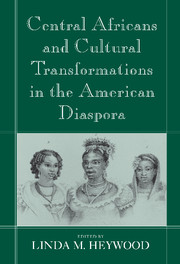Book contents
- Frontmatter
- Contents
- List of Contributors
- Foreword
- Acknowledgments
- Introduction
- PART ONE CENTRAL AFRICA: SOCIETY, CULTURE, AND THE SLAVE TRADE
- PART TWO CENTRAL AFRICANS IN BRAZIL
- PART THREE CENTRAL AFRICANS IN HAITI AND SPANISH AMERICA
- 7 Twins, Simbi Spirits, and Lwas in Kongo and Haiti
- 8 The Central African Presence in Spanish Maroon Communities
- 9 Central African Popular Christianity and the Making of Haitian Vodou Religion
- 10 Kongolese Catholic Influences on Haitian Popular Catholicism: A Sociohistorical Exploration
- PART FOUR CENTRAL AFRICANS IN NORTH AMERICA AND THE CARIBBEAN
- Index
8 - The Central African Presence in Spanish Maroon Communities
Published online by Cambridge University Press: 28 October 2009
- Frontmatter
- Contents
- List of Contributors
- Foreword
- Acknowledgments
- Introduction
- PART ONE CENTRAL AFRICA: SOCIETY, CULTURE, AND THE SLAVE TRADE
- PART TWO CENTRAL AFRICANS IN BRAZIL
- PART THREE CENTRAL AFRICANS IN HAITI AND SPANISH AMERICA
- 7 Twins, Simbi Spirits, and Lwas in Kongo and Haiti
- 8 The Central African Presence in Spanish Maroon Communities
- 9 Central African Popular Christianity and the Making of Haitian Vodou Religion
- 10 Kongolese Catholic Influences on Haitian Popular Catholicism: A Sociohistorical Exploration
- PART FOUR CENTRAL AFRICANS IN NORTH AMERICA AND THE CARIBBEAN
- Index
Summary
Maroons have long captivated historians and popular audiences alike. Their daring and initiative in the face of terrible oppression and relentless persecution command our interest and sympathy, and yet only a few almost superhuman figures emerge from the historical treatment and the folk legends. Most maroons remained anonymous and little specific is known about them – their names, their origins, or ethnicity. What little we can determine about the people who risked their lives for freedom is in great part shaped by which slave system they challenged and which, therefore, recorded their history. Iberian legal, religious, and social traditions recognized the humanity of all slaves, including Africans, and this ethos led bureaucrats and churchmen to create a more complete ethnographic record of the enslaved in Latin America than is found in areas where they were considered chattel. Other scholars in this volume examine the linkages between Africa and Portuguese Brazil, which boasts the most well-known and significant of all maroon quilombos, Palmares. I will, however, contain myself to my own research on maroons living in communities known as palenques, cumbes, or manieles in the Spanish Americas. I draw on the ethnographic data available in a wide variety of Spanish colonial documentary sources and read closely for the material world described in them, as well as in the nascent archaeological record. Guided by the path-breaking work of some of the fine Africanists represented in this collection, I address possible cultural clues discernible in military–political and socioreligious practices of the maroons to make some preliminary arguments about the ubiquitous presence and the impact of Central Africans among them.
- Type
- Chapter
- Information
- Publisher: Cambridge University PressPrint publication year: 2001
- 1
- Cited by



